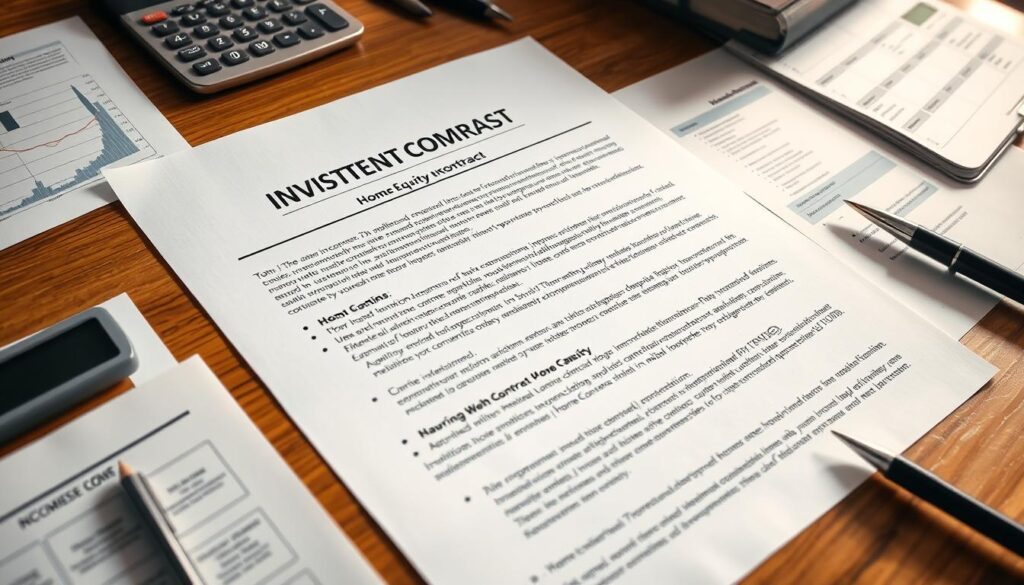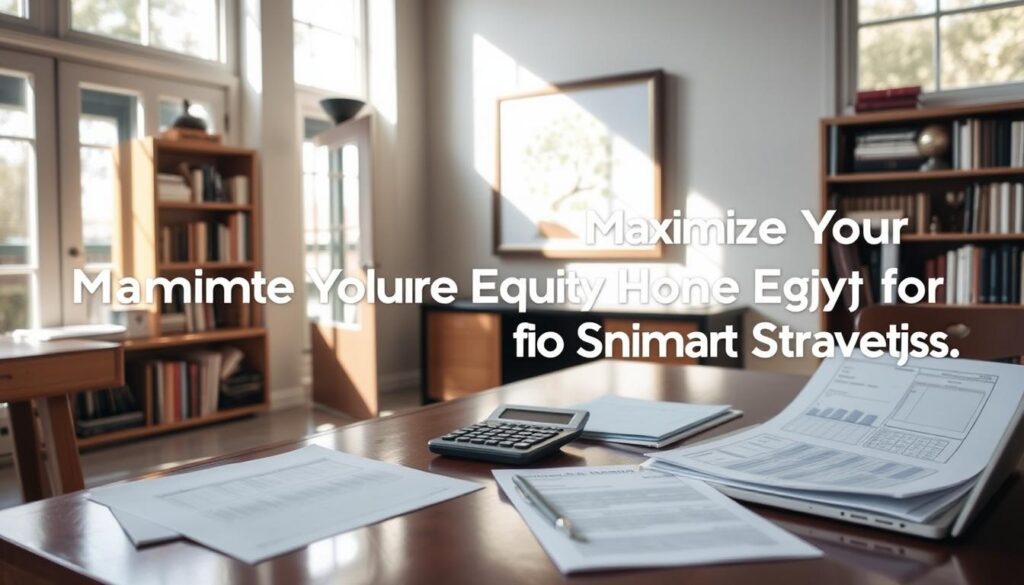Did you know U.S. homeowners hold over $7 trillion in untapped home equity? That’s enough potential capital to rethink how you approach big financial moves. This guide helps you explore whether a home equity investment (HEI) fits your goals.
Imagine accessing funds tied to your home’s value without monthly payments or selling your property. This article breaks down how HEI compares to options like HELOCs or cash-out refinances, showing how it might work for you. We’ll cover risks, benefits, and steps to decide if your home’s equity can support your plans—from renovations to debt consolidation.
Understanding Home Equity Investment
Home equity investment (HEI) offers homeowners a way to tap into their property’s value without traditional loans. Let’s break down what is HEI and why it matters. Imagine your home’s equity as stored wealth—you can unlock it through this strategy.
What is Home Equity Investment?
HEI involves partnering with investors who buy a share of your home’s equity. Unlike mortgages, you don’t make monthly payments. Instead, you agree to repay the investment plus a share of your home’s future value when you sell or refinance. This approach keeps cash flowing now without the pressure of regular due dates.
Benefits of Investing Your Home Equity
- No monthly payments: Repay only when you sell or refinance.
- Flexible terms: Avoid strict credit score requirements common in loans.
- Upfront cash access: Turn home value into funds for repairs, education, or debt consolidation.
These benefits of home equity can empower you to pursue goals without daily financial strain. Whether renovating or funding a business, HEI provides options tailored to your timeline.
Assessing Your Financial Situation
Before exploring home equity investment options, take time to assessing financial situation. Start by reviewing your credit score, monthly income, and existing debts. Lenders often require minimum credit scores for home equity loans or lines of credit. Check your score online through services like Experian or TransUnion to see where you stand.
- Credit health: Scores above 620 improve HEI eligibility chances
- Income stability: Lenders prefer consistent employment history
- Debt-to-income ratio: Aim below 43% for better approval odds
Compare your personal finance details with traditional loan requirements. HEI often offers lower interest rates than credit cards or personal loans, even for borrowers with average credit. For example, the Federal Reserve reports HELOC rates averaging 5.25% vs. 16%+ for credit cards in 2023.
Use free tools like the CFPB’s financial calculator to model scenarios. Ask yourself: Can you comfortably repay loans using home equity as collateral? This step ensures you avoid overextending while unlocking the potential locked in your property.
Evaluating Your Home’s Equity Potential
Before diving into investments, home equity potential depends on both your property’s value and market conditions. Start by calculating your current equity to see how much you could access.
Determining Your Home’s Current Equity
Calculate your equity by subtracting your remaining mortgage balance from your home’s current market value. For example, if your home appraises at $400,000 and you owe $200,000, your equity is $200,000. Use online tools like Zillow’s Zestimate or consult a local realtor for precise valuations. Regular appraisals help track changes over time.
Market Factors Influencing Equity Value
External forces like neighborhood demand, interest rates, and economic trends shape market factors affecting your equity. Consider these key influences:
- Local Demand: Growing neighborhoods with good schools or jobs boost values.
- Housing Supply: Scarcity of homes in your area can increase your property’s worth.
- Economic Shifts: Job growth or industry changes may alter long-term home equity potential.
Stay informed about regional trends through platforms like CoreLogic or Redfin’s market reports. Fluctuations in market factors mean regular checks keep you ahead of changes.
Exploring Home Equity Investment Terms and Options
When diving into home equity investments, familiarizing yourself with investment terms and HEI options is key. Let’s break down what matters most:
- Investment terms like repayment schedules or equity shares define how profits are split between you and the investor. Check fees, duration, and exit strategies clearly.
- HEI options vary: some focus on short-term gains, others on long-term partnerships. Review how each aligns with your financial goals.

Unlike traditional loans, HEI models often let you retain home ownership while sharing equity growth. For instance, some HEI options offer fixed returns, while others depend on property value changes. Compare these to HELOCs or loans by focusing on risk levels and control.
Always verify investment terms like origination fees (often 1-5% of your home’s value) or appreciation splits. Resources like HEI explained clarify terms like “equity participation rate” or “amortization periods.”
Choosing the right HEI options starts with knowing your priorities. Are you after quick cash or long-term stability? Match your needs to the terms outlined in contracts to avoid surprises later.
How to Determine if Home Equity Investment Is Right for You
Align your financial goals with the right investment models to ensure your home equity strategy fits your needs. Start by clarifying what you hope to achieve—like funding home upgrades or consolidating debt—then match these priorities with available options.
Identifying Your Financial Goals
Are you targeting short-term cash flow or long-term flexibility? Financial goals like avoiding monthly payments or accessing up to $500k should guide your choice. HEI’s no-DTI structure works best for goals prioritizing repayment flexibility, like projects completed years before selling.
Comparing Investment Models
| Factor | Home Equity Investment (HEI) | Traditional Home Equity Loan |
|---|---|---|
| Credit Score | Min 500+ | Typically 650+ |
| Repayment | One-time balloon at sale | Monthly payments |
| Max Funds | $500k | Varies by lender |
| DTI Considered? | No | Yes |
HEI’s structure avoids monthly obligations but ties repayment to home value at exit. Explore repayment scenarios to see how market fluctuations impact outcomes. Choose a model aligning with your risk tolerance and timeline.
Navigating the Investment Process
Turning your home equity into a financial opportunity starts with clarity. Follow this guide to map out every stage of the investment process and gather actionable expert tips to stay on track.
Step-by-Step Process Overview
- Prequalification Check: Contact lenders to assess your eligibility based on credit score, income, and home value.
- Application Submission: Gather documents like tax returns, pay stubs, and property titles to complete the loan application.
- Appraisal: A professional evaluates your home’s current market value to determine loan-to-value ratios.
- Agreement Signing: Review terms like interest rates and repayment timelines before finalizing the loan contract.
- Repayment Planning: Set up a budget that aligns with your income to manage payments effectively.
Expert Tips for a Smooth Journey
- Start early: Begin the preapproval process months before needing funds to avoid delays.
- Shop around: Compare rates and terms from multiple lenders to secure the best deal.
- Ask questions: Clarify how rate changes or loan terms could impact your finances long-term.
- Document organization: Keep all financial records in one folder for quick access during negotiations.
Remember, patience and preparation are key. By following these steps and leveraging expert advice, you’ll turn your equity into a tool for growth without stress.
Maximizing Your Home’s Value Post-Investment
After securing your home equity investment, focus on home value improvement through smart choices. Small upgrades can amplify your property’s appeal and resale potential.
Renovation Strategies to Increase Value
Prioritize projects with high return rates:
- Kitchen updates: Replace outdated cabinets and appliances to add curb appeal.
- Bathroom upgrades: Install modern vanities and energy-efficient fixtures.
- Outdoor spaces: Add a deck or hardscaping to boost outdoor living areas.
| Project | Avg. Cost | Return on Investment |
|---|---|---|
| Mid-Range Kitchen | $40,000 | 75% |
| Basic Bathroom Remodel | $15,000 | 78% |
| Deck Installation | $13,000 | 82% |
Data from Remodeling Magazine’s 2023 Cost vs. Value Report confirms these projects deliver top returns.
Maintenance Practices for Long-Term Benefits
Regular upkeep keeps your investment secure:
- Inspect roofs and gutters annually to prevent leaks.
- Paint exteriors every 5 years to maintain curb appeal.
- Update HVAC filters quarterly and service systems biannually.
Maintaining these steps ensures your property stays in top condition, supporting long-term equity growth.
Avoiding Common Pitfalls in Home Equity Investment
Every home equity investment (HEI) comes with HEI risks worth understanding. Let’s break down the common pitfalls that could trip up your plans. Many homeowners overlook hidden details until it’s too late.
- Complex Contracts: Fine print might tie you to terms you didn’t expect. Some agreements demand you share 50% or more of future home value gains with the investor.
- Unexpected Costs: Repairs, fluctuating interest rates, or market downturns can inflate what you owe. A 2023 study by the National Association of Realtors found 34% of HEI borrowers faced surprise expenses.
- Overextending: Borrowing more than needed leaves less equity for emergencies. Adjustable-rate terms could spike monthly payments if your income dips.
Protect yourself by reviewing contracts with a financial advisor. Ask lenders like Quicken Loans or Rocket Mortgage to clarify HEI risks. Always calculate worst-case scenarios: What happens if your home value drops 10%? Can you repay if interest rates rise?
Knowledge is key—avoiding these common pitfalls ensures your investment grows your wealth, not your stress. Stay informed to keep control of your home’s future.
Conclusion
Choosing a home equity investment (HEI) involves weighing how it fits your financial picture. This HEI conclusion highlights that no monthly payments or interest charges make it distinct, but your final decision should align with your long-term goals. Providers often set a 75% maximum CLTV, so check your equity share first. Agreements last 10 to 30 years, letting you buy out terms early or exit when selling. Repayment depends on your home’s value changes, so knowing market trends matters.
Before moving forward, review your equity potential and financial priorities. A home equity investment can offer cash now but impacts future ownership. Visit AspireHEI’s candidate guide to assess if your situation matches HEI terms. Ask yourself: Does this align with plans to renovate, pay debts, or invest elsewhere?
Take time to compare HEI models and consult professionals. While the option avoids traditional loan risks, it ties your financial health to home value shifts. Your final decision should reflect comfort with shared appreciation terms and clarity on repayment scenarios. Making an informed choice ensures you protect—and grow—your investment wisely.



